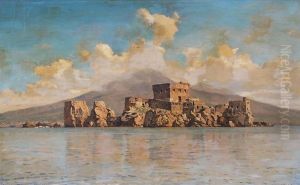Nerly Friedrich Paul Paintings
Friedrich Paul Nerly, born in 1807 in Erfurt, Germany, was a distinguished 19th-century landscape painter whose work primarily focused on capturing the picturesque and often sublime essence of Italian landscapes and cityscapes. His full name being Friedrich Paul Nerly the Elder, he is sometimes confused with his son, Friedrich Nerly the Younger, who was also a talented painter. Nerly's artistic journey began in his native Germany, but his quest for the classical and romantic allure of landscapes led him to Italy, a country that had long attracted artists from across Europe with its rich history, stunning scenery, and luminous light.
Nerly settled in Venice, a city that captivated him with its unique interplay of water, light, and architecture. He became particularly known for his detailed and atmospheric depictions of Venice, capturing the city’s evocative moods and its architectural marvels with a precision and sensitivity that resonated with viewers and collectors alike. His works often featured the Grand Canal, Piazza San Marco, and various Venetian festivities, rendered with a meticulous attention to the effects of light and reflection that gave his paintings a vivid, almost ethereal quality.
Throughout his career, Nerly was influenced by the Romantic movement, which emphasized emotion and individualism as well as the glorification of the past and nature. This is evident in his dramatic skies, turbulent seas, and the overall sense of awe that pervades his landscapes. Despite the romantic undercurrents, his work also displayed a commitment to realism, particularly in his accurate architectural details and the lively depiction of figures within his scenes.
Nerly's contributions to landscape painting were significant in the context of 19th-century European art. He bridged the gap between the romantic and the real, offering views that were not only accurate renditions but also imbued with a sense of the sublime. His legacy is preserved in the collections of various European museums, where his works continue to be studied and admired for their beauty and historical value. Friedrich Paul Nerly died in 1878, leaving behind a body of work that continues to enchant and inspire viewers with its luminous portrayal of Italy’s enduring charm.

